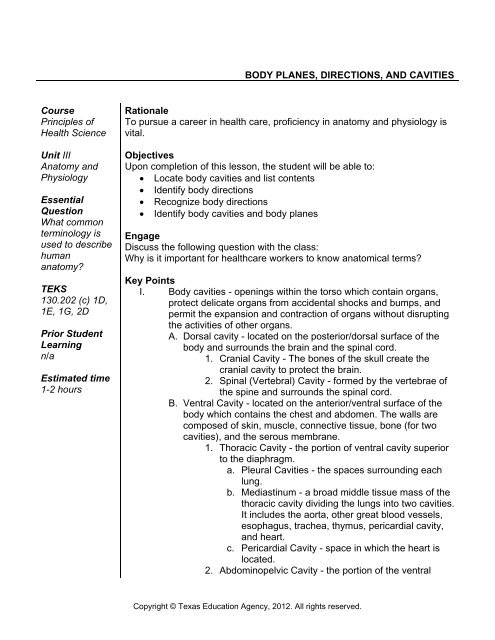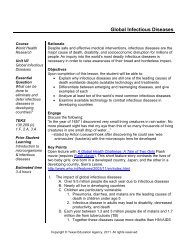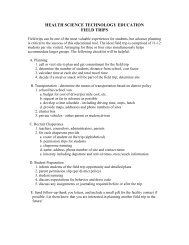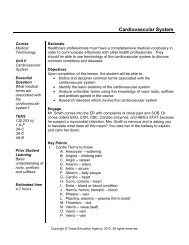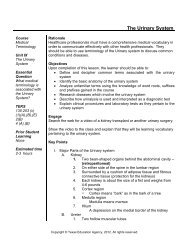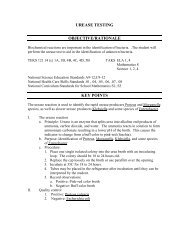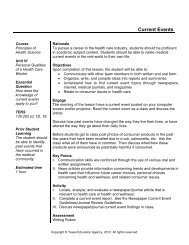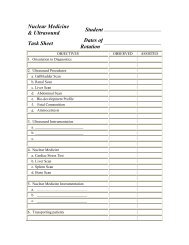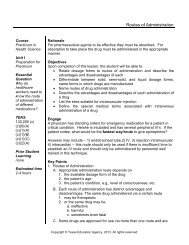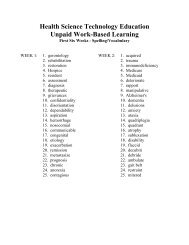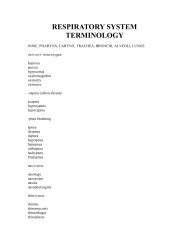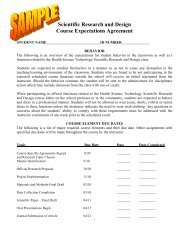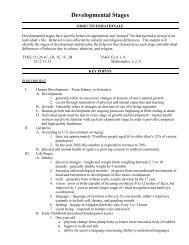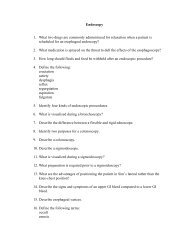Body Planes, Directions and Cavities - Texas Health Science!
Body Planes, Directions and Cavities - Texas Health Science!
Body Planes, Directions and Cavities - Texas Health Science!
Create successful ePaper yourself
Turn your PDF publications into a flip-book with our unique Google optimized e-Paper software.
BODY PLANES, DIRECTIONS, AND CAVITIES<br />
Course<br />
Principles of<br />
<strong>Health</strong> <strong>Science</strong><br />
Unit III<br />
Anatomy <strong>and</strong><br />
Physiology<br />
Essential<br />
Question<br />
What common<br />
terminology is<br />
used to describe<br />
human<br />
anatomy?<br />
TEKS<br />
130.202 (c) 1D,<br />
1E, 1G, 2D<br />
Prior Student<br />
Learning<br />
n/a<br />
Estimated time<br />
1-2 hours<br />
Rationale<br />
To pursue a career in health care, proficiency in anatomy <strong>and</strong> physiology is<br />
vital.<br />
Objectives<br />
Upon completion of this lesson, the student will be able to:<br />
Locate body cavities <strong>and</strong> list contents<br />
Identify body directions<br />
Recognize body directions<br />
Identify body cavities <strong>and</strong> body planes<br />
Engage<br />
Discuss the following question with the class:<br />
Why is it important for healthcare workers to know anatomical terms?<br />
Key Points<br />
I. <strong>Body</strong> cavities - openings within the torso which contain organs,<br />
protect delicate organs from accidental shocks <strong>and</strong> bumps, <strong>and</strong><br />
permit the expansion <strong>and</strong> contraction of organs without disrupting<br />
the activities of other organs.<br />
A. Dorsal cavity - located on the posterior/dorsal surface of the<br />
body <strong>and</strong> surrounds the brain <strong>and</strong> the spinal cord.<br />
1. Cranial Cavity - The bones of the skull create the<br />
cranial cavity to protect the brain.<br />
2. Spinal (Vertebral) Cavity - formed by the vertebrae of<br />
the spine <strong>and</strong> surrounds the spinal cord.<br />
B. Ventral Cavity - located on the anterior/ventral surface of the<br />
body which contains the chest <strong>and</strong> abdomen. The walls are<br />
composed of skin, muscle, connective tissue, bone (for two<br />
cavities), <strong>and</strong> the serous membrane.<br />
1. Thoracic Cavity - the portion of ventral cavity superior<br />
to the diaphragm.<br />
a. Pleural <strong>Cavities</strong> - the spaces surrounding each<br />
lung.<br />
b. Mediastinum - a broad middle tissue mass of the<br />
thoracic cavity dividing the lungs into two cavities.<br />
It includes the aorta, other great blood vessels,<br />
esophagus, trachea, thymus, pericardial cavity,<br />
<strong>and</strong> heart.<br />
c. Pericardial Cavity - space in which the heart is<br />
located.<br />
2. Abdominopelvic Cavity - the portion of the ventral<br />
Copyright © <strong>Texas</strong> Education Agency, 2012. All rights reserved.
II.<br />
III.<br />
cavity inferior to the diaphragm.<br />
a. Abdominal Cavity - The superior portion of the<br />
abdominopelvic cavity. It extends from the<br />
diaphragm to the superior margin of the pelvic<br />
girdle. The abdominal cavity contains the organs<br />
known as the viscera which include the stomach,<br />
spleen, liver, gallbladder, pancreas, small<br />
intestine, <strong>and</strong> most of the large intestine.<br />
b. Pelvic Cavity - the pelvic cavity is surrounded by<br />
the pelvic bones. The pelvic cavity contains the<br />
urinary bladder, cecum, appendix, sigmoid colon,<br />
rectum, <strong>and</strong> the male or female internal<br />
reproductive organs.<br />
Abdominal Regions – the abdominal/pelvic cavity is so large that it<br />
is divided into regions<br />
A. One method of division is quadrants. Quadrants divide the<br />
abdominal/pelvic cavity into four sections using the belly button<br />
as the point of reference for both the horizontal <strong>and</strong> vertical<br />
lines.<br />
1. Right upper quadrant (RUQ)<br />
2. Left upper quadrant (LUQ)<br />
3. Right lower quadrant (RLQ)<br />
4. Left lower quadrant (LLQ)<br />
B. A more precise method of division is abdominal regions. This<br />
method divides the area into a tic tac toe board<br />
1. Epigastric – above the stomach<br />
2. Umbilical – neat the umbilicus or belly button<br />
3. Hypogastric / pelvic – below the stomach<br />
4. Hypochondriac – below the ribs<br />
5. Lumbar/Lateral – near the large bones of the spinal<br />
cord<br />
6. Iliac / inguinal – near the groin<br />
<strong>Body</strong> planes - refer to any slice or cut through a three-dimensional<br />
structure allowing us to visualize relationships between those<br />
parts. CT <strong>and</strong> MRI technology use these principles.<br />
A. Sagittal: divides the body or organ vertically into right <strong>and</strong> left<br />
unequal parts: words used with the sagittal plane includemedial,<br />
lateral, proximal <strong>and</strong> distal.<br />
B. Midsagittal: divides the body or organ vertically into equal right<br />
<strong>and</strong> left parts<br />
C. Frontal/ Coronal: a vertical plane dividing the body or an organ<br />
into anterior (front) <strong>and</strong> posterior (back) sections.<br />
D. Transverse: a horizontal plane dividing the body or an organ<br />
into superior (upper) <strong>and</strong> inferior (lower) sections.<br />
Copyright © <strong>Texas</strong> Education Agency, 2012. All rights reserved.
IV.<br />
<strong>Body</strong> <strong>Directions</strong><br />
A. Superior – upper, or above something<br />
B. Inferior – lower, or below something<br />
C. Anterior or Ventral – front, in front of<br />
D. Posterior– After, behind, following, toward the rear<br />
E. Medial – Toward the mid-line, middle, away from the side<br />
F. Lateral – toward the side of the body - away from the mid-line<br />
G. Proximal – toward or near the trunk of the body, near the point<br />
of attachment to the body<br />
H. Distal – Away from, farther from the origin or attachment to the<br />
body<br />
I. Dorsal: Near the upper surface, toward the back<br />
J. Ventral: Toward the bottom, toward the belly<br />
K. Rostral: Toward the front<br />
L. Cranial - refers to the head of the body<br />
M. Caudal – means tail end<br />
N. Internal – inside the body<br />
Activity<br />
I. In pairs, create a stick-like figure, with a head, trunk, arms, <strong>and</strong> legs<br />
using clay. As the terms are discussed, the student will use a<br />
toothpick to designate the area. After all the terms are discussed, cut<br />
the figure into the planes.<br />
II. In pairs, identify the following areas on partner:<br />
Area distal to the knee.<br />
Area proximal to the elbow.<br />
Lateral to the big toe.<br />
Anterior side of the body.<br />
Posterior side of the body.<br />
Area that is medial to the shoulder.<br />
Area that is superior to the lungs.<br />
Area that is inferior to the heart.<br />
III. Complete Color the <strong>Cavities</strong> <strong>and</strong> Color the Abdominal Regions<br />
activity.<br />
IV. Complete the <strong>Body</strong> <strong>Planes</strong> <strong>and</strong> <strong>Directions</strong> activity.<br />
V. Develop a Short Story describing best date or worst nightmare using<br />
anatomical terms.<br />
VI. Show students copies of CT-scans <strong>and</strong> quiz them on which body<br />
plane is being used.<br />
Assessment<br />
Writing Rubric<br />
<strong>Body</strong> Orientation Quiz <strong>and</strong> Key<br />
Copyright © <strong>Texas</strong> Education Agency, 2012. All rights reserved.
Materials<br />
Assorted colors of clay<br />
Crayons<br />
Colored toothpicks<br />
Paper plates<br />
Rulers<br />
Bananas<br />
Permanent markers<br />
http://www.ama-assn.org/ama/pub/physician-resources/patient-educationmaterials/atlas-of-human-body.shtml<br />
- atlas of the human body<br />
Utah State Office of Education, (2005). Medical Anatomy <strong>and</strong> Physiology<br />
Teacher Resource CD. Utah.<br />
Accommodations for Learning Differences<br />
For reinforcement, the students will make flashcards of all of the terms.<br />
For enrichment, the students will develop questions <strong>and</strong> design a jeopardy<br />
game utilizing the information in this unit.<br />
National <strong>and</strong> State Education St<strong>and</strong>ards<br />
National <strong>Health</strong> <strong>Science</strong> Cluster St<strong>and</strong>ards<br />
HLC01.01 Academic Foundations<br />
<strong>Health</strong> care workers will know the academic subject matter required (in<br />
addition to state high school graduation requirements) for proficiency within<br />
their area. They will use this knowledge as needed in their role.<br />
HLC1O.01 Technical Skills<br />
<strong>Health</strong> Care Workers will apply technical skills required for all career<br />
specialties. They will demonstrate skills <strong>and</strong> knowledge as appropriate.<br />
TEKS<br />
130.202 (c)(1)(D) organize, compile, <strong>and</strong> write ideas into reports <strong>and</strong><br />
summaries;<br />
130.202 (c) (1)(E) plan <strong>and</strong> prepare effective oral presentations; <strong>and</strong><br />
130.202 (c) (1)(G) describe biological <strong>and</strong> chemical processes that maintain<br />
homeostasis.<br />
130.202 (c)(2)(D) accurately interpret, transcribe, <strong>and</strong> communicate medical<br />
vocabulary using appropriate technology.<br />
<strong>Texas</strong> College <strong>and</strong> Career Readiness St<strong>and</strong>ards<br />
English Language Arts<br />
II. B. Underst<strong>and</strong> new vocabulary <strong>and</strong> concepts <strong>and</strong> use them accurately in<br />
reading writing <strong>and</strong> speaking.<br />
III. B. Develop effective speaking styles for both groups <strong>and</strong> one on one<br />
Copyright © <strong>Texas</strong> Education Agency, 2012. All rights reserved.
situations.<br />
IV. A. Apply listening skills as an individual <strong>and</strong> as a member of a group in a<br />
variety of settings.<br />
IV. B. 2. Listen actively <strong>and</strong> effectively in one-on-one communication<br />
situations.<br />
<strong>Science</strong><br />
1.E.1. Use several modes of expression to describe or characterize natural<br />
patterns <strong>and</strong> phenomena. These modes of expression include narrative,<br />
numerical, graphical, pictorial, symbolic, <strong>and</strong> kinesthetic.<br />
1.E.2. Use essential vocabulary of the discipline being studied.<br />
3.A.1. Use correct applications of writing practices in scientific<br />
communication.<br />
Copyright © <strong>Texas</strong> Education Agency, 2012. All rights reserved.
Color<br />
the <strong>Cavities</strong><br />
Using a diagram of the human body, label <strong>and</strong> color code each of the following.<br />
Ventral Cavity<br />
Thoracic Cavity<br />
Pleural <strong>Cavities</strong><br />
Pelvic Cavity<br />
Mediastinum<br />
Pericardial Cavity<br />
Abdominopelvic Cavity<br />
Abdominal Cavity<br />
Copyright © <strong>Texas</strong> Education Agency, 2012. All rights<br />
reserved.
Color<br />
the <strong>Cavities</strong><br />
Using a diagram of the human body, label <strong>and</strong> color code each of the following.<br />
Dorsal cavity<br />
Spinal (Vertebral) Cavity<br />
Cranial Cavity<br />
Copyright © <strong>Texas</strong> Education Agency, 2012. All rights<br />
reserved.
Color the Abdominal<br />
Regions<br />
A. Color<br />
the following drawing<br />
using the body regions:<br />
1. Right iliac- purple<br />
2. Epigastric- red<br />
3. Left lumbar-<br />
blue<br />
4. Right hypochondriac- yellow<br />
5. Umbilical- orange<br />
6. Left iliac- pink<br />
7. Right lumbar-green<br />
8. Hypogastric<br />
c- brown<br />
9. Left hypochondriac- leave blank<br />
B. Using<br />
a black marker label the 4 abdominal quadrants.<br />
Copyright © <strong>Texas</strong> Education Agency, 2012. All rights<br />
reserved.
<strong>Body</strong> <strong>Planes</strong> <strong>and</strong> <strong>Directions</strong> Activity<br />
<strong>Planes</strong> <strong>and</strong> directions are practiced using fruit <strong>and</strong> toothpicks.<br />
Be careful with the surgical instruments. Read <strong>and</strong> follow the instructions very carefully.<br />
Materials:<br />
Knives<br />
Marker<br />
Colored toothpicks<br />
Bananas<br />
Rulers<br />
Banana:<br />
Cut the banana with a transverse plane. Stick a blue toothpick in the superior end of the<br />
banana. Place red toothpick in the most distal point on the right inferior piece. Make a 3cm<br />
midsagittal incision on the posterior inferior portion of your banana. Place a yellow toothpick at<br />
the anterior superior medial section of the banana. With a maker place a (X) on the left posterior<br />
superior lateral section on your banana.<br />
Copyright © <strong>Texas</strong> Education Agency, 2012. All rights reserved.
Short Story<br />
Incorporate the following terms into a story describing your describing your worst nightmare.<br />
Underline the term(s) in the story.<br />
Superior<br />
Inferior<br />
Anterior<br />
Abdominal Cavity<br />
Dorsal<br />
Pelvic Cavity<br />
Medial<br />
Oral Cavity<br />
Lateral<br />
Proximal<br />
Distal<br />
Superficial<br />
Deep<br />
Skeletal System<br />
Cardiovascular System<br />
Copyright © <strong>Texas</strong> Education Agency, 2012. All rights reserved.
<strong>Body</strong> Orientation Quiz<br />
1. Describe how a body would be divided by each of the following types of planes:<br />
A. Frontal (Coronal)<br />
B. Midsagittal<br />
C. Sagittal<br />
D. Transverse<br />
2. Identify the correct directional term to complete the following statements.<br />
A. The liver is ___________ to the diaphragm.<br />
B. Fingers are located_____________ to the wrist bones.<br />
C. The skin on the dorsal surface of your body is said to be located on your____<br />
surface.<br />
D. The great (big) toe is _____ to the little toe.<br />
E. The skin on your leg is _____ to the muscle tissue in your leg.<br />
F. When you float face down in a pool, you are lying on your _____ surface.<br />
G. The lungs <strong>and</strong> the heart are located _____ to the abdominal organs.<br />
3. Identify which cavity each of the following organs are in:<br />
A. Heart __________________ G. Lungs __________________<br />
B. Liver __________________ H. Spleen __________________<br />
C. Intestines __________________ I. Kidneys __________________<br />
D. Spinal Cord __________________ J. Stomach __________________<br />
E. Brain __________________ K. Urinary Bladder ________________<br />
F. Sex Organs __________________ L. Pancreas __________________<br />
4. Fill in the blank completing the analogy.<br />
A. anterior is to ventral as posterior is to _____________________________<br />
B. superficial is to external as deep is to _____________________________<br />
C. cranial is to caudal as superior is to ______________________________<br />
D. medial is to lateral as proximal is to ______________________________<br />
Copyright © <strong>Texas</strong> Education Agency, 2012. All rights reserved.
5. Match the organs with the cavity they are in.<br />
CAVITY<br />
1.____ cranial cavity<br />
2.____ spinal cavity<br />
3.____ thoracic cavity<br />
4.____ abdominal cavity<br />
5.____ pelvic cavity<br />
ORGAN<br />
A. stomach<br />
B. reproductive organs<br />
C. brain<br />
D. small intestines<br />
E. urinary bladder<br />
F. spinal cord<br />
G. liver, gallbladder, pancreas<br />
<strong>and</strong> spleen<br />
H. lung<br />
6. Match the abdominal region with the descriptive term:<br />
1. ______ Iliac/ingiuinal A. above the stomach<br />
2. ______ Epigastric B. near the belly button<br />
3. ______ Lumbar/lateral C. below the stomach<br />
4. ______ hypochondriac D. below the ribs<br />
5. ______ Umbilical E. near the large bones of spinal cord<br />
6. ______ hypogastric/ pelvic F. near the groin<br />
("Medical anatomy <strong>and</strong>," 2005)<br />
Copyright © <strong>Texas</strong> Education Agency, 2012. All rights reserved.
Quiz Key<br />
1. Describe how a body would be divided by each of the following types of planes:<br />
A. Frontal (coronal) - divides body into anterior <strong>and</strong> posterior sections.<br />
B. Midsagittal - divides body into equal right <strong>and</strong> left sides.<br />
C. Sagittal - divides body into right <strong>and</strong> left sides.<br />
D. Transverse - divides body into superior <strong>and</strong> inferior sections.<br />
2. Identify the correct directional term to complete the following statements.<br />
A. The liver is inferior to the diaphragm<br />
B. Fingers are located distal to the wrist bones.<br />
C. The skin on the dorsal surface of your body is said to be located on your<br />
posterior surface.<br />
D. The great(big) toe is medial to the little toe.<br />
E. The skin on your leg is superficial to the muscle tissue in your leg.<br />
F. When you float face down in a pool, you are lying on your anterior surface.<br />
G. The lungs <strong>and</strong> the heart are located superior to the abdominal organs.<br />
3. Identify which cavity each of the following organs are in:<br />
A. Heart ventral/mediastinal G. Lungs ventral/pleural<br />
B. Liver abdominal H. Spleen abdominal<br />
C. Intestines abdominal I. Kidneys abdominal<br />
D. Spinal Cord vertebral J. Stomach abdominal<br />
E. Brain cranial K. Urinary Bladder pelvic<br />
F. Sex Organs pelvic L. Pancreas- abdominal<br />
4. Fill in the blank completing the analogy.<br />
A. anterior is to ventral as posterior is to dorsal<br />
B. superficial is to external as deep is to internal<br />
C. cranial is to caudal as superior is to inferior<br />
D. medial is to lateral as proximal is to distal<br />
5. Match the organs with the cavity they are in.<br />
CAVITY<br />
ORGAN<br />
1. C cranial cavity A. stomach<br />
2. F spinal cavity B. reproductive organs<br />
3. H thoracic cavity C. brain<br />
4. A, D, G abdominal cavity D. small intestines<br />
5. B, E pelvic cavity E. urinary bladder<br />
F. spinal cord<br />
G. liver, gallbladder, pancreas<br />
<strong>and</strong> spleen<br />
H. lung<br />
Copyright © <strong>Texas</strong> Education Agency, 2012. All rights reserved.
6. Match the abdominal region with the descriptive term:<br />
1. __F____ Iliac/ingiuinal A. above the stomach<br />
2. ___A___Epigastric B. near the belly button<br />
3. ____E__ Lumbar/lateral C. below the stomach<br />
4. ___D___ hypochondriac D. below the ribs<br />
5. ____B__ Umbilical E. near the large bones of spinal cord<br />
6. ___C___ hypogastric/ pelvic F. near the groin<br />
("Medical Anatomy <strong>and</strong>," 2005)<br />
Copyright © <strong>Texas</strong> Education Agency, 2012. All rights reserved.


